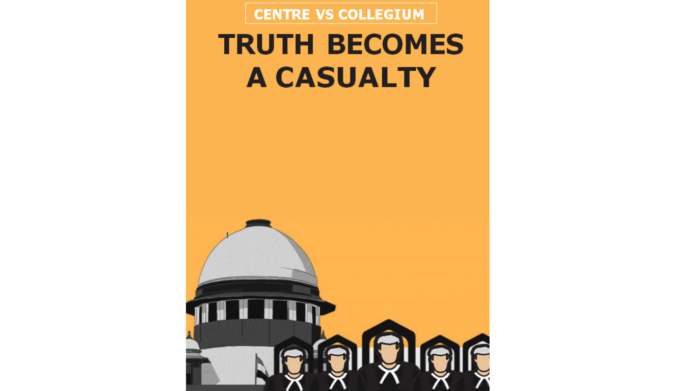There is no clarity on the government’s pick-and- choose policy when it comes to acting on Collegium advice. When it accuses the Collegium of being opaque, it forgets that it promotes opacity, not transparency, writes A.J. Philip.
Awitness has to take an oath before deposition in a court of law in the country. The oath is as follows, although the language varies from court to court: “I do swear in the name of God/solemnly affirm that I shall state the truth, the whole truth, and nothing but the truth.” The truth is qualified as the “whole truth” and “nothing but the truth.”
The oath makes it clear that the court does not want to hear any coloured truths or half-truths. During the Mahabharata war, for example, it was announced that Ashwatthma, the elephant, had been killed. When this was announced, the announcer said the words “the elephant” in a lower voice. The purpose was to mislead Dronacharya into believing that his son Ashwatthma was killed in the war.
Dronacharya was so shocked by the news that he lost all interest in the war. He became an easy prey for the Pandavas.The complete truth was that an elephant named Ashwatthma was killed, and Dronacharya was not bereaved. This shows how crucial the “whole truth” is to reaching a conclusion. The government and the Supreme Court have been indulging in half- truths on the issue of Collegium.
First and foremost, let us define the Collegium system. If you check the Constitution of India, which is the most voluminous Constitution in the world, you will not find the word “Collegium” there. If one goes by the dictionary, “Collegium” means “a group in which each member has approximately equal power and authority.”
It came into vogue in the early nineties when the Centre was led by a string of leaders, who could only be described as weak as they did not enjoy any groundswell of support.The Supreme Court made use of the situation to introduce what came to be known as the system of Collegium to select, appoint, and promote judges of the High Courts and the Supreme Court through its own verdicts. As I mentioned, the government was too weak to resist it.
Until the early nineties, it was the government of the day that decided who should be the High Court and supreme court judges. It is nobody’s contention that the government selected only yes men and yes women as judges. Justices of the calibre of VR Krishna Iyer also came up through this system, however flawed it was.The Collegium system that replaced the earlier system cannot be described as flawless by any standard. Anyway, under the Collegium system, the chief justice of a High Court and the two seniormost judges of the same court form the Collegium that chooses judges in an almost informal manner.
There is an apex Collegium headed by the Chief Justice of India and four senior-most judges on the Supreme Court. This Collegium vets the names suggested by the various High Courts. It not only chooses judges for the Supreme Court but also promotes judges from High Courts to the post of chief justices of High Courts. It also decides all transfer cases.
The government does not have much of a role in this process. It has to do a background check on the candidates. The government can reject any candidate, but once the Collegium re-recommends the same person for appointment, it has to comply with the Collegium’s recommendation.
“The government enacted legislation in 2014 to establish the National Judicial Appointment Commission (NJAC) to appoint judges. NJAC envisioned a new appointment system in which the Chief Justice of India could only remain silent as the government would serve as both judge and executioner.“
The Chief justices of the High Courts and the Supreme Court are by and large based on seniority, so much so that it can be predicted whether a judge would become a chief justice and, if so, on what date. This system had been running smoothly until Narendra Modi took over as Prime Minister.
For once, the government realised that it could not fill the posts of judges with its nominees. It wanted to have a greater say in the selection process. In 2014, the government managed to enact a law to set up the National Judicial Appointment Commission (NJAC) to appoint judges. Incidentally, the Bill was passed almost unanimously.The NJAC envisaged a new system of appointment in which the Chief Justice of India did not enjoy a pivotal role. All he or she could do was remain a mute witness, as the government would be both the judge and the executioner.
It is little wonder that the Supreme Court struck down the Act in exercise of its power to review any law cleared by Parliament. The government could have filed a review petition if it felt that what the court did was unacceptable. However, it preferred not to do anything, perhaps to prove the point that it was not interested in bridling the judiciary.
If someone thought that the government acquiesced in the court’s decision, she could not be faulted for it. However, few realised that the government was waiting for an opportune moment to hit back at the Collegium. It is not possible to trace the showdown to any particular incident.
In the selection and appointment of judges, the government has used whatever power it still has. Kuttiyil Mathew Joseph was the longest-serving chief justice of Uttarakhand. He is believed to have gotten into the bad books of the government for a verdict that questioned the Centre’s decision to impose the President’s rule on the state.
The Collegium chose him for elevation to the Supreme Court. The government sat on the file for so long that it ensured that he would retire before becoming chief justice of India. At the Supreme Court, judges get their seniority not on the basis of their age but on the basis of the date on which they join the court as judges. The tenure the judge had at the High Court is not counted.
Justice Joseph, who was the son of Justice KK Mathew, was appointed only after the Collegium insisted on having him on the bench of the apex court. There have been innumerable cases of the government sitting tight on the proposals mooted by the Collegium.There is little transparency in the functioning of the Collegium. Nobody knows for sure what criteria are followed by the Collegium in the selection of judges. It does not have a structure like the Union Public Service Commission to select judges. What is in vogue is an informal system.
Nobody can say with certainty that an informal system is the best way to find people of integrity and competence among the country’s 140 million people. There is no reservation for the post of judge. When KR Narayanan was president of the country, he wrote a letter to the Chief Justice of India, hinting at the desirability of having some sort of reservation while selecting judges.The President was lampooned for making the suggestion. In fact, one fortnightly journal that tried to imitate Time magazine by using a plethora of adjectives and adverbs for every noun and verb it used, published an ugly picture of the President on its cover page.
However, the fact remains that the apex court judges are chosen from a small basket of judges. Is it any surprise that sons and daughters of former judges become judges? Of course, there will be some representation for minorities and Dalits. I do not have to elaborate on which section a vast majority of the judges come from.There have been some specific cases where judges chosen under the system of Collegium have had to be transferred. In fact, one had to be jailed. This showed that due diligence was not observed in the selection process. As I mentioned, the Collegium does not have the infrastructure that a public service commission has.
While the apex court struck down the NJAC Act, it preferred not to take a bold stand on many issues. For instance, the citizenship law, which questions one of the basic structures of the Constitution, was not subjected to judicial scrutiny. Similarly, the abrogation of Article 370 of the Constitution escaped such scrutiny.One of the chief justices who came up through the system of Collegium accepted the nomination to the Rajya Sabha soon after he retired from the apex court. Even if it was not an act of quid pro quo, the appointment was certainly questionable. From any angle, the Collegium system cannot be said to be perfect.
The other day, Union Minister for Law and Justice Kiren Rijiju fired a salvo at the Collegium system. He wants a representative of the government to be a part of the Collegium when it deliberates on these issues.He made the demand in a letter to Chief Justice D.Y. Chandrachud. It is difficult to see the letter in isolation, as the Centre has been consistently putting the Collegium under pressure so that it wilts. In fact, Rijiju has been working in tandem with the vice-chairman of the Rajya Sabha and the speaker of the Lok Sabha, who also have a bone to pick with the Collegium.
If the collective bid is seen as an attempt to bring about transparency in the functioning of the Collegium, it is totally erroneous. Had that been the case, there would have been greater transparency on the part of the government on why it has been sitting tight on some of the proposals made by the Collegium.There is no clarity on the pick-and-choose policy the government exercises when it comes to acting on the advice of the Collegium. When it accuses the Collegium of lacking in transparency, it forgets that it promotes opaqueness, not transparency.
Innumerable are the Constitutional and other senior posts that are filled routinely by the government. Does anyone other than a few in the top echelons know the rationale for the selection, which is nothing but arbitrary? The gubernatorial posts are routinely filled with party men or yes men who do not have any knowledge of how to uphold the Constitution at all times in all their dealings.They seem to believe that their job is to keep the chief ministers, if they happen to be posted in states ruled by non-BJP chief ministers, on tenterhooks. The only criterion used in the selection of people is their loyalty to the party or its leader.
A report that cast aspersions on the selection process followed by the Collegium would have made more sense if the government had, for instance, justified the grounds on which Muslims are not given representation in the council of ministers, even though they constitute at least 15 percent of the population. The condition of the Christians is not any better.
True, there is a need for the Collegium to pick up from a larger basket of lawyers and judges. The same can be said about the government, which is also very discriminatory in its selection process.The argument advanced by the chairman of the Rajya Sabha, Jagdeep Dhankar, that the striking down of the law enacted by Parliament would have made some sense if Parliament had been more accommodating. The entire country is aware of how much public life has been disrupted in the country as a result of the government’s determination to force agricultural laws down the farmers’ throats.
“The Collegium does not have a structure for selecting judges like the Union Public Service Commission. Nobody knows for certain what criteria the Collegium uses to select judges.“
The presiding officers often conduct themselves as henchmen of the ruling party rather than as the symbol of the autonomy the Houses enjoy. In other words, the government has no moral right to question the Collegium.By now, the people know the intentions of the government. It has captured all the institutions of power. From the President to the Vice-Chancellors, all the nominees are members of the party or the prime minister.In 2014, when the NJAC Bill was discussed, most parties supported the government. Today, there are few takers for Kiren Rijiju’s argument because they know that he does not say the “whole truth” and “nothing but the truth”!
Courtesy: Indian Currents (www.indiancurrents.org)







